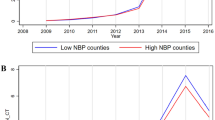Abstract
The Gramm-Leach-Bliley Act of 1999 amended the lending authority of the Federal Home Loan Banks to include advances secured by small enterprise loans of community financial institutions. Three reasons for the extension of this selective credit subsidy to community banks and thrifts are examined, including the possible need to: subsidize community depository institutions, stabilize the Federal Home Loan Banks, and address a market failure in rural markets for small enterprise loans. We empirically investigate whether funding constraints impact the small-business lending decision by rural community banks. We estimate static and dynamic models of small-business lending by community banks. The data reject the hypothesis that access to increased funds will increase the amount of small-business loans made by community banks.
Similar content being viewed by others
References
Berger, A. N., and G. F. Udell. “The Economics of Small Business Finance: The Roles of Private Equity and Debt Markets in the Financial Growth Cycle.” Journal of Banking and Finance 22,no. 6–8 (1998), 613–673.
Berger, A. N., and G. F. Udell. “Relationship Lending and Lines of Credit in Small Firm Finance.” Journal of Business 68,no. 3 (1995), 351–381.
Boot, A. W. A, and A. V. Thakor. “Can Relationship Banking Survive Competition?” Journal of Finance 55,no. 2 (2000), 679–713.
Bradbury, D. Deputy Assistant Secretary of the Treasury for Federal Finance, Statement before the Subcommittee on Education, Arts, and Humanities of the Senate Committee on Labor and Human Resources (June 20, 1995).
Congressional Budget Office. Federal Subsidies and the Housing GSEs. Washington, DC: Government Printing Office, 2001.
Congressional Budget Office. Assessing the Public Costs and Benefits of Fannie Mae and Freddie Mac. Washington, DC: Government Printing Office, 1996.
Craig, Ben R., and James B. Thomson. “Federal Home Loan Bank Lending to Community Banks: Are Targeted Subsidies Necessary?” Federal Reserve Bank of Cleveland Working Paper 0112, August, 2001.
Feldman, R. “Estimating and Managing the Federal Subsidy of Fannie Mae and Freddie Mac: Is Either Task Possible.” Journal of Pubic Budgeting, Accounting, and Financial Management (1998), 81–116.
Flannery, Mark J. “Capital Regulation and Insured Banks' Choice of Individual Loan Default Risk.” Journal of Monetary Economics (September 1989), 235–258.
Goldfeld, Stephen M. Commercial Bank Behavior and Economic Activity, Contributions to Economic Analysis, 43 Amsterdam: North-Holland Publishing Company, 1966.
Harvey, J., and J. Padget. “Subchapter S—A New Tool for Enhancing the Value of Community Banks.” Financial Industry Perspectives (December), Federal Reserve Bank of Kansas City (2000), 17–31.
Heuson, A., W. Passmore, and R. Sparks. “Credit Scoring and Mortgage Securitization: Do They Lower Mortgage Rates?” Finance and Economics Discussion Series 2000–44, Federal Reserve Board, Washington, DC, 2000.
Jackson, William, III. “Market Structure and the Speed of Price Adjustments: Evidence of Non-Monotonicity.” Review of Industrial Organization 12 (1997), 37–57.
Kane, E. J. “Housing Finance GSEs: Who Gets the Subsidy?” Journal of Financial Services Research 15,no. 3 (1999), 197–209.
Kane, E. J. The S&L Insurance Mess: How Did it Happen? Washington, DC: Urban Institute Press, 1989.
Kane, E. J. “Good Intentions and Unintended Evil: The Case Against Selective Credit Allocation.” Journal of Money, Credit and Banking 9,no. 1 (1977), 55–69.
Kane, E. J. “Short-Changing the Small Saver: Federal Government Discrimination against the Small Saver During the Vietnam War.” Journal of Money, Credit, and Banking 2,no. 4 (1970), 513–522.
Kane, E. J., and B. G. Malkiel. “Bank Portfolio Allocation, Deposit Variability, and the Availability Doctrine.” Quarterly Journal of Economics 89 (February 1965), 113–134.
Laderman, Elizabeth, and Wayne Passmore. “Do Savings Associations Have a Special Commitment to Housing?” Journal of Financial Services Research 17,no. 1 (2000), 41–64.
Maloney, D. K., and J. B. Thomson. “Gramm-Leach-Bliley's Federal Home Loan Bank Provisions.” Economic Commentary Federal Reserve Bank of Cleveland, 2002 (forthcoming).
McDonough, J. E. “The Federal Home Loan Bank System.” American Economic Review 24,no. 4 (1934), 668–685.
Neumark, D., and S. A. Sharpe. “Market Structure and the Nature of Price Rigidity: Evidence from the Market for Consumer Deposits.” Quarterly Journal of Economics 107,no. 2 (1992), 657–680.
Osterberg, W. P., and J. B. Thomson. “Banking Consolidation and Correspondent Banking.” Economic Review, Federal Reserve Bank of Cleveland (First Quarter 1999), 9–20.
Petersen, M. A., and R. G. Rajan. “The Benefits of Lending Relationships: Evidence from Small Business Data.” Journal of Finance 49,no. 1 (1994), 3–37.
Petersen, M. A., and R. G. Rajan. “The Effect of Credit Market Competition on Lending Relationships.” Quarterly Journal of Economics 110, (1994), 403–444.
Student Loan Marketing Association. A Guide to the Student Loan Marketing Association Reorganization Act of 1996 (October), Washington, DC.
Smith, Rixey, and Norman Beasley. Carter Glass: A Biography New York, NY: Longmans, Green and Co., 1939.
Stojanovic, D., M. D. Vaughan, and T. J. Yeager. “Is Federal Home Loan Bank Funding a Risky Business for the FDIC?” The Regional Economist (October), Federal Reserve Bank of St. Louis (2000), 4–9.
Author information
Authors and Affiliations
Rights and permissions
About this article
Cite this article
Craig, B.R., Thomson, J.B. Federal Home Loan Bank Lending to Community Banks: Are Targeted Subsidies Desirable?. Journal of Financial Services Research 23, 5–28 (2003). https://doi.org/10.1023/A:1022191726414
Issue Date:
DOI: https://doi.org/10.1023/A:1022191726414




